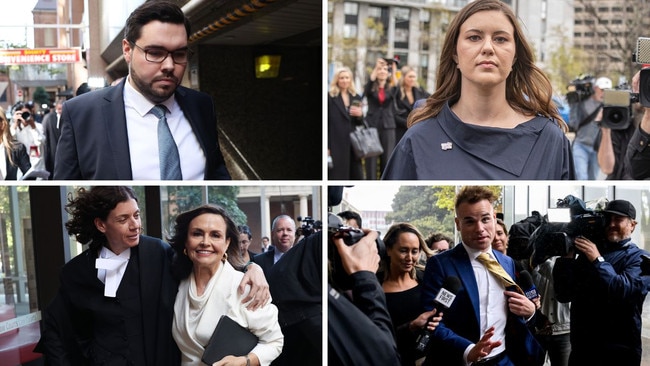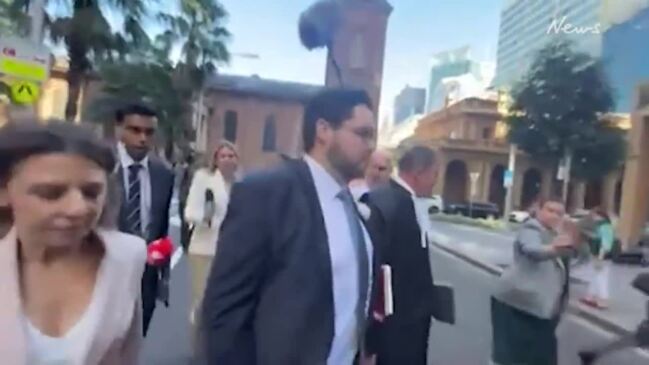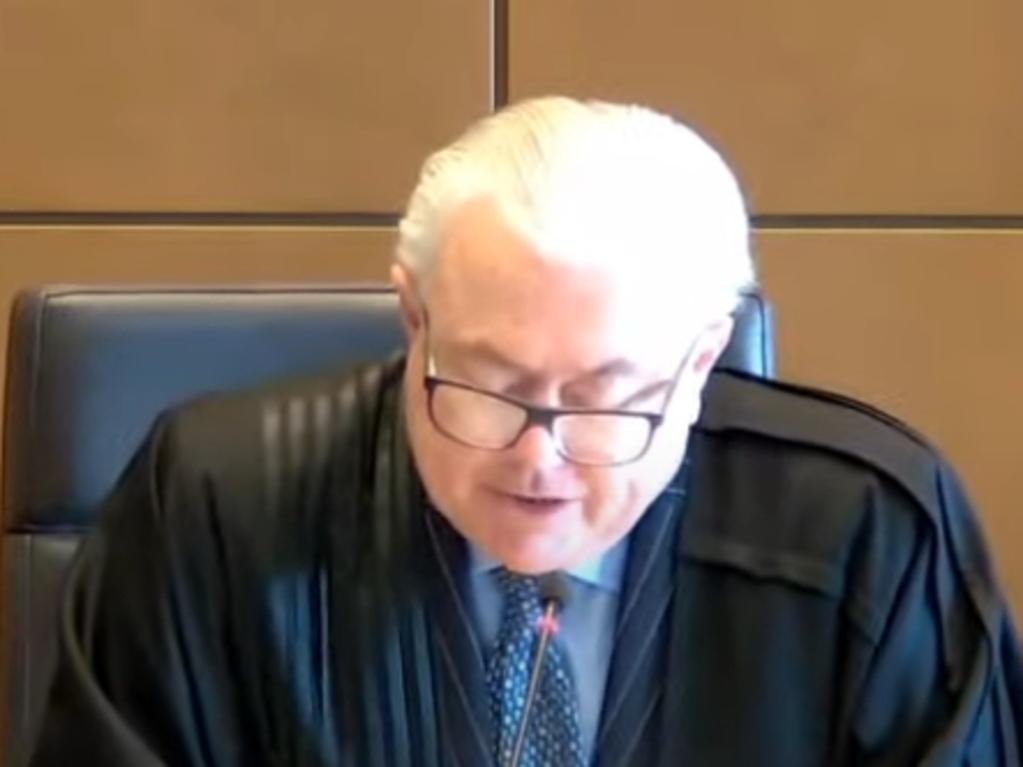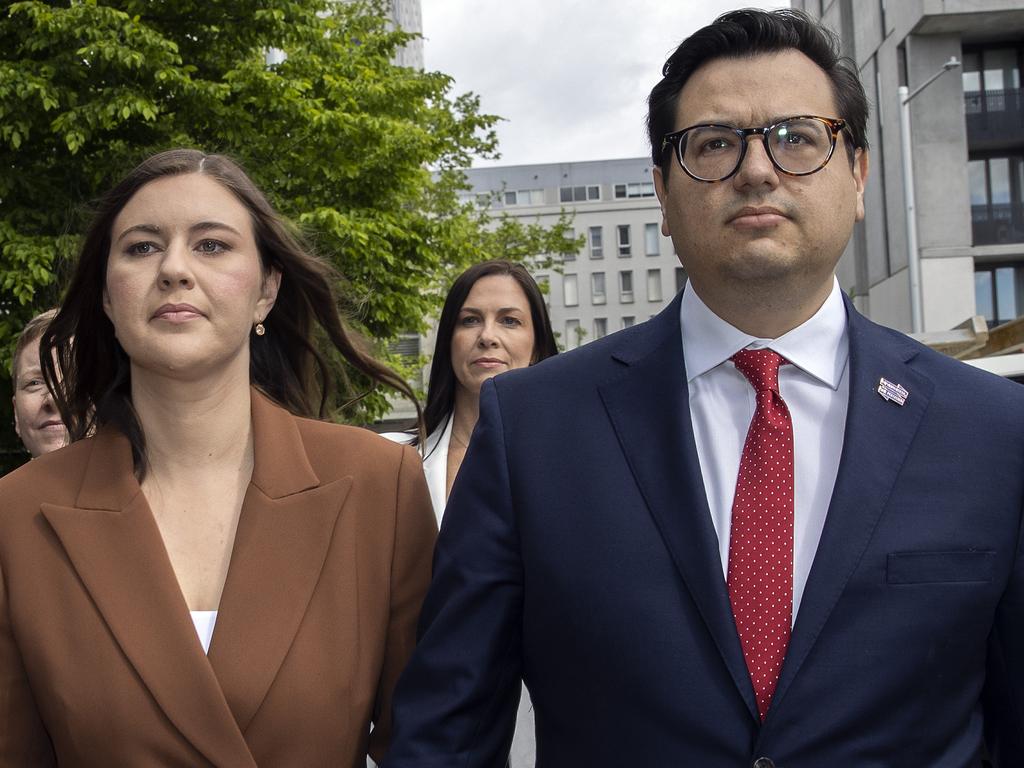
After flirting with it as a “cause celebre” that had caused “collateral damage” and taken numerous “unexpected detours”, Lee described it more fittingly as an “omnishambles”.
Every judgment needs a touch of Latin and colour early on.
Omni, Latin for everything; shambles, a word from long ago to describe a medieval butcher’s slaughterhouse.
Apparently, the words were joined together first in the BBC mock political series The Thick Of It in 2009.
Oxford Dictionary’s word of the year in 2021, here it was, revived again in courtroom one on level 21 of the Federal Court building in Sydney.
Just minutes into the live stream of Lee reading extracts from his 324-page judgment, there was another unexpected detour.
Once again, Lee’s final judgment was delayed. The court audio was lost. More than 25,000 people were left hanging for the result.
One imagines the judge was not impressed by the technology failure. X – formerly Twitter – had some fun though, with one wag suggesting the court’s tech guy was reaching out to Lehrmann’s karaoke tech guy for assistance.
Tech issues resolved, Lee delivered critical parts from a judgment the country needed. He spoke for almost three hours. At the end more than 45,000 were watching.
Lee said the judgment was not for people who have made up their minds. He’s right. Reactions from some, their celebrations, ignore important parts of the judgment that don’t suit them.
Lee follows the evidence forensically, scrupulously, fairly. The result is that Lee found, on the balance of probabilities, that Lehrmann raped Higgins.
Lee found no evidence of a political cover-up about a rape.
Many are celebrating the first finding. Did any of those people encourage Higgins to go to the police, rather than turn a rape allegation into a political conspiracy?
That second finding, rejecting a political cover-up, puts a judicial stake through the dark heart of this rotten scandal – once and for all.
There are many losers from this judgment. And only two clear winners. Both women. They are Linda Reynolds and, more particularly, Fiona Brown.
Lehrmann raped Higgins
Lehrmann is the biggest loser. He gambled big and lost the most. As Lee said: “Having escaped the lion’s den, Mr Lehrmann made the mistake of coming back for his hat.”
The criminal trial was aborted; there were no findings against him. ACT Director of Public Prosecutions Shane Drumgold decided against a second trial.
Lehrmann could have walked away. There would be damning findings against the chief prosecutor for misconduct during that trial. But now a judge has found – on the civil standard of proof – that Lehrmann raped Higgins.

Evidence rejected
Lee couldn’t be clearer: “I reject the entirety of Mr Lehrmann’s account as to what occurred in the ministerial suite.”
The judge explained that a finding of rape depended on “an actual persuasion of the existence of a fact before it can be found; the seriousness of the allegation of knowledge of non-consent; the extent of its unlikelihood; and separately, the gravity of the consequences flowing from the finding.”
Lee found that Lehrmann went back to Parliament House that night, not to write up notes about French submarines nor to show Higgins Qing dynasty ceramics.
Lee said Lehrmann “hitherto had demonstrated no outward signs of being a workaholic” to add credence to claims of going to the office to jot down some work notes after 1.40am that fateful night.
Based on the evidence, the judge found that Lehrmann was “hellbent on having sex with a woman he: (a) found sexually attractive; (b) had been mutually passionately kissing and touching; (c) had encouraged to drink; and (d) knew had reduced inhibitions because she was very drunk”.
“In his pursuit of gratification, he did not care one way or another whether Ms Higgins understood or agreed to what was going on,” the judge said.
Ten and Wilkinson made out their truth defence. There are no damages for Lehrmann. Costs will, presumably, be awarded against him. He may have to declare himself bankrupt. His reputation, his life, is in tatters.
That is so even after Lee emphasised that there was a substantive difference between the criminal standard of proof and the civil standard of proof.
The judge was “not obliged to reach that degree of certainty necessary to support conviction upon a criminal charge”.
Network failures
The reputations of Ten, Llewellyn and Wilkinson are damaged.
Ten and Wilkinson failed to establish that their conduct in publishing allegation of rape and a political conspiracy to cover up a rape was reasonable.
The judge eviscerated The Project’s lack of curiosity, the “lack of rigour” when it came to examining Higgins’ version of events.
Lee took aim at producer Angus Llewellyn who appeared to be “uninterested in reflecting upon Mr Sharaz’s motives”.
Sharaz had made his intention for the timing of the interview clear. He planned to liaise with an opposition frontbencher – Labor’s Katy Gallagher – to deploy the allegations against the Morrison government during question time.
Llewellyn told the court that he didn’t think Sharaz had a political motive. Lee wasn’t impressed, finding that “any journalist who did not think Mr Sharaz had a motivation to inflict immediate political damage would have to be wilfully blind”.
The judge slated The Project’s lack of reasonable scrutiny of many claims by Higgins, including that her phone had been “remotely wiped”.
“One would have thought this was a warning light alerting to the necessity for care in assessing whether the maker of such a representation was open to speculation and conspiracies,” Lee said.
When it came to Higgins’ claim that a photo of a bruised leg to corroborate the rape allegation, Lee said “no attempt was made to ascertain how this corroborative document had survived in circumstances where Ms Higgins asserted that she had lost data from her phone”.
Lee said the lack of follow-up on important issues “reflected a general absence of detachment and investigative rigour.” The judge found that despite the seriousness of the allegations to be made during The Project interview, “there was no genuine desire to engage with anyone other than Ms Higgins in terms of content for the broadcast”.
Lee said that Wilkinson’s desire to advocate for victims of sexual assault was well-intentioned. But it undermined “fairness” and “independence” when The Project reported Higgins’ allegation of sexual assault and a political cover-up.
Wilkinson, he said “instinctively believed Ms Higgins must be telling the truth and Senator Reynolds must be lying”.
“Of course, she was perfectly entitled to her view, but it is not redolent of the conduct of a highly experienced journalist dealing with facts, not instincts, and ensuring any belief or commitment did not undermine fairness or independence,” he said.
Lee found Wilkinson lacked candour in the witness box by refusing initially to admit that the Logies speech conveyed the representation that Higgins’ rape allegation was credible and to be believed.
Wilkinson’s credibility is damaged. She came to court extolling her long history as a journalist.
Lee rejected her claims that she had conducted herself reasonably as a journalist.
‘Cover-up’ wrong
There was no political cover-up. On the final page, in the penultimate paragraph of his judgment, the judge repeated his most visceral criticism about allegations of political corruption.
“The publication of accusations of corrupt conduct in putting up roadblocks and forcing a rape victim to choose between her career and justice won the Project team, like Ms Maiden, a glittering prize; but when the accusation is examined properly, it was supposition without reasonable foundation in verifiable fact; its dissemination caused a brume of confusion, and did much collateral damage – including to the fair and orderly progress of the underlying allegation of sexual assault through the criminal justice system,” the judgment said.
“To the extent there were perceived systemic issues as to avenues of complaint and support services in parliament, this may have merited a form of fact-based critique, not the publication of insufficiently scrutinised and factually misconceived conjecture.”
A win with catches
Higgins doesn’t walk away from this judgment undamaged. The judge carefully distinguished events in March 2019 from those that unfolded in early 2021 after Higgins met Sharaz.
The judge found that “numerous aspects of the conduct of Ms Higgins in the years following 2019 were far more troubling” than any of the inconsistencies or false statements made in the hours and days after that night in a ministerial office.
Lee found that the most troubling part “was the way in which Ms Higgins crafted a narrative accusing others of putting up roadblocks and forcing her two years earlier of having to choose between her career and seeking justice by making and pursuing a complaint”.
Lee said this allegation of a political cover-up “was perceived by The Project team as being the most important aspect of The Project program and its deployment meant her account achieved much notoriety and public interest”.
Lee said Higgins’ account to be replete with “inconsistencies”, “falsities”, particularly her claims against Brown. Lee took aim at “imprecisions” in Higgins’ evidence and her reliance upon “speculation and conjecture.”
The judge found the political cover-up allegations were based on Higgins’ feelings – not facts – noting that the former staffer used “the highly ambiguous word ‘weird’ (or variations, such as people were “acting weirdly”) no less than 82 times” in her initial account to The Project team.
Lawyer in frame
Lee delivered damning criticism for Ten and its senior litigation lawyer, Tasha Smithies, in encouraging Wilkinson to make her infamous Logies speech.
Lee said the “conduct of Network Ten through its employees in procuring Ms Wilkinson to give the speech in the form it was given, for the reason it was given, was grossly improper and unjustifiable”.
“It was conduct apt to cause disruption to the criminal justice system and, without the Chief Justice making the orders she did, could have imperilled Mr Lehrmann’s right to a fair trial,” he said.

Lee was particularly savage about Smithies’ inability to recognise her failures. In the witness box Smithies even went so far as to say she was not “personally or professionally embarrassed by the advice” she gave Wilkinson.
This clearly aggravated Lee. He said: “It is one thing to make a mistake, even a serious mistake – after all, to err is to be human. But I regret to say that the continuing lack of insight by Ms Smithies as to the inappropriateness of her conduct related to the speech reflects, in my view, a lack of proper appreciation of her professional obligations as a solicitor and her paramount duty to the court and the administration of justice: see r 3.1, Legal Profession Uniform Law Australian Solicitors’ Conduct Rules 2015 (NSW).”
His reference to a specific rule is ominous for Smithies. He appears to be hinting to the bodies that regulate solicitors to investigate her conduct, and helpfully telling them what rule they should be looking at in doing so.
Source of integrity
Fiona Brown is the clearest winner to emerge from this judgment.
In a judgment that offered searing criticism of the evidence given by numerous witnesses, Lee was full of praise for Reynolds’ former chief of staff.
“Despite having her health seriously affected by allegations of shameful conduct and (like the other principal actors) experiencing a torrent of social media abuse, she gave evidence in a calm way, and was responsive to questions,” Lee said.
He noted particularly that she stood up to her superiors when she felt they were suggesting a course of action that may have been in their interests but was not in Higgins’ interests nor otherwise appropriate.
He said: “This showed integrity in resisting pressure she subjectively considered inappropriate and evinced a concern for the autonomy and welfare of Ms Higgins. In these circumstances, to be later vilified as an unfeeling apparatchik willing to throw up roadblocks in covering up criminal conduct at the behest of one’s political overlords must be worse than galling.”
Lee dealt head on with the direct conflict between Higgins’ account of both her actions and Brown’s responses, and the account Brown gave of Higgins conduct. He had to do this when addressing the claims Higgins made in support of her compensation claim against the commonwealth.
Commonwealth payout
The judge made a number of salient points about Higgins’ $2.4m settlement with the commonwealth.
He said it was not his role to look at the process or the propriety of the payment. He was only concerned with her creditworthiness as a witness.
On that score, Lee pointed out that Higgins made several key representations in her settlement deed with the commonwealth that conflicted with Brown’s evidence.
Lee found that “several things being alleged (by Higgins) were untrue.”
These included that Higgins had told Brown that Lehrmann had sexually assaulted her; that Yaron Finkelstein from the Prime Minister’s office was a “regular presence” in Reynolds office advising Brown on how to deal with Higgins; that Brown rebuffed Higgins’ request to view CCTV footage from the relevant night; that Brown was unhelpful in discussing sick leave; that Brown “made it clear by her words and demeanour that the events of 22/23 March 2019 must be put to one side” and; that Higgins “ought remain silent about the sexual assault, in order to keep her job/career”.
On each of these matters, Lee preferred Brown’s evidence.
The cover-up allegation was political dynamite. It transformed a serious but confined rape allegation – a he said/she said conflict – into a national scandal and a potential election changer.
Reynolds and Brown suffered grievously from the wicked and untrue allegation of a political cover up.
The judge’s resounding praise for Brown’s conduct and evidence suggests to some observers that the commonwealth should be considering paying Brown damages, ex gratia if necessary, for the damage done to her in the course of her employment. A sum of at least $2.4m would seem to be appropriate.
What’s next?
The National Anti-Corruption Commission.
Lee’s damning findings about the false claims Higgins made to procure the payment to her of $2.4m should be front and centre for Justice Paul Brereton, the head of the NACC.
Making false claims to secure money from the commonwealth should always be something the corruption watchdog investigates seriously.
Given this claim was politically beneficial to the then opposition – possibly helping it to win an election – and given new Attorney-General Mark Dreyfus gave directions to Reynolds that prevented Higgins’ claims being tested, Brereton must be on high alert. And Labor should be nervous.
Defamation case #2
Higgins has made shocking claims about the way she says Reynolds treated her.
Lee’s clear rejection of the cover-up allegation and associated claims may be helpful for Reynolds in her defamation case against Higgins and Sharaz.
These findings by Lee will surely raise questions as to whether Higgins has taken any steps to put her $2.4m payment, or any part of it, beyond the reach of an adverse defamation judgment. The Australian understands that Higgins set up a trust, active from February 9 last year, called The Brittany Higgins Protective Trust.
In other words, though Lee’s job is done, and a fine one he did, this omnishambles is not yet over.








Federal Court judge Michael Lee settled on the perfect word to describe the long-running saga involving Brittany Higgins and Bruce Lehrmann.